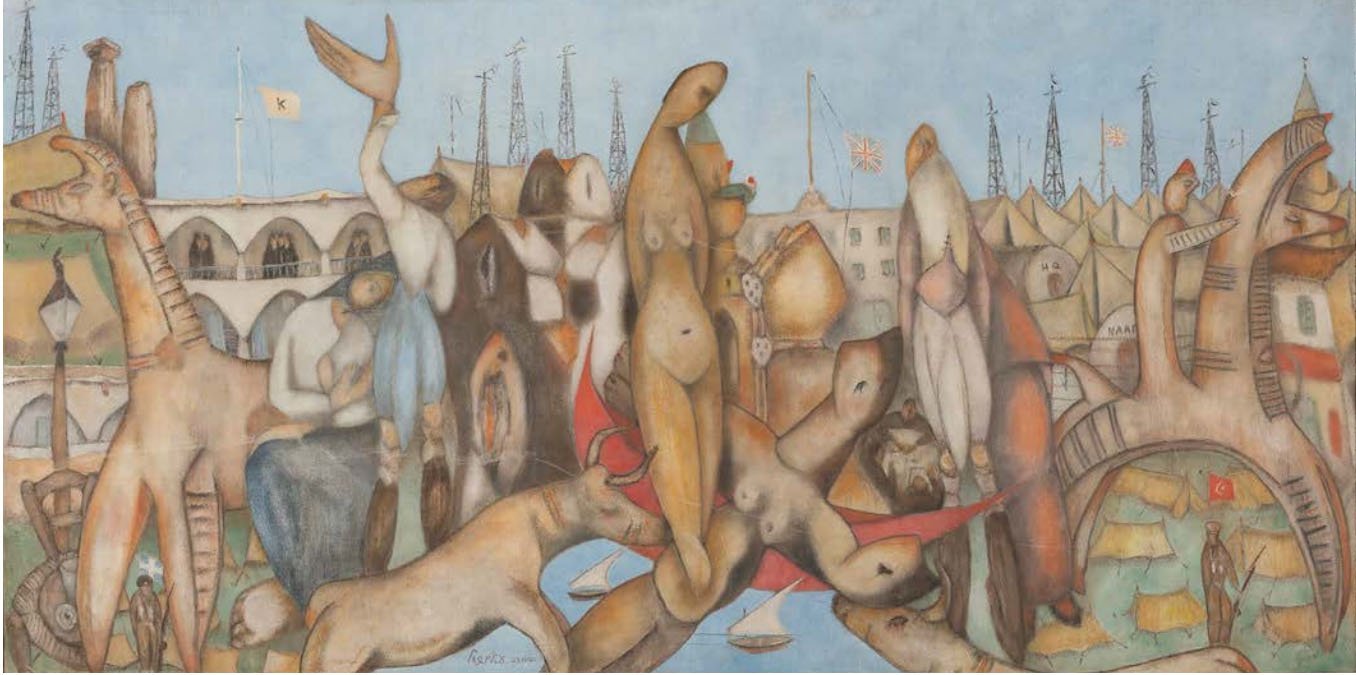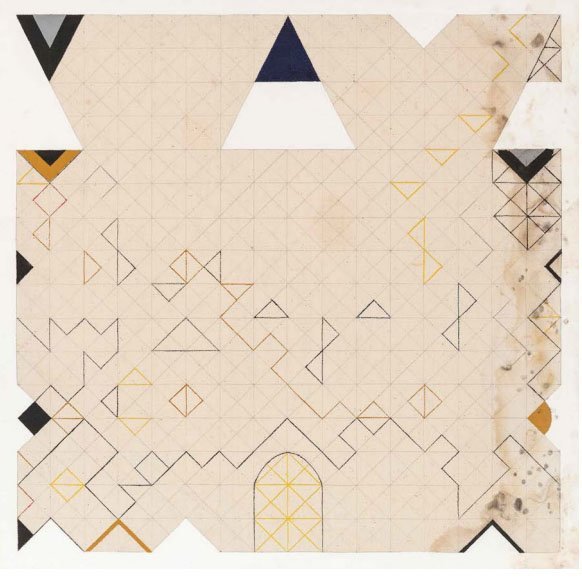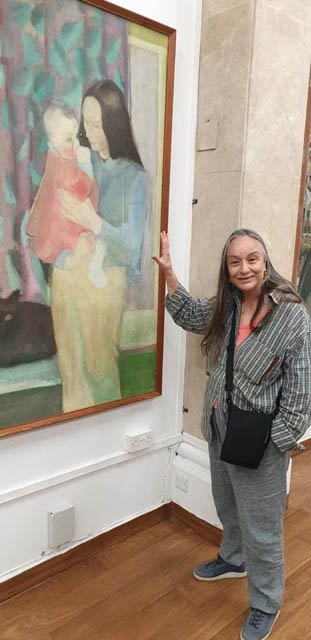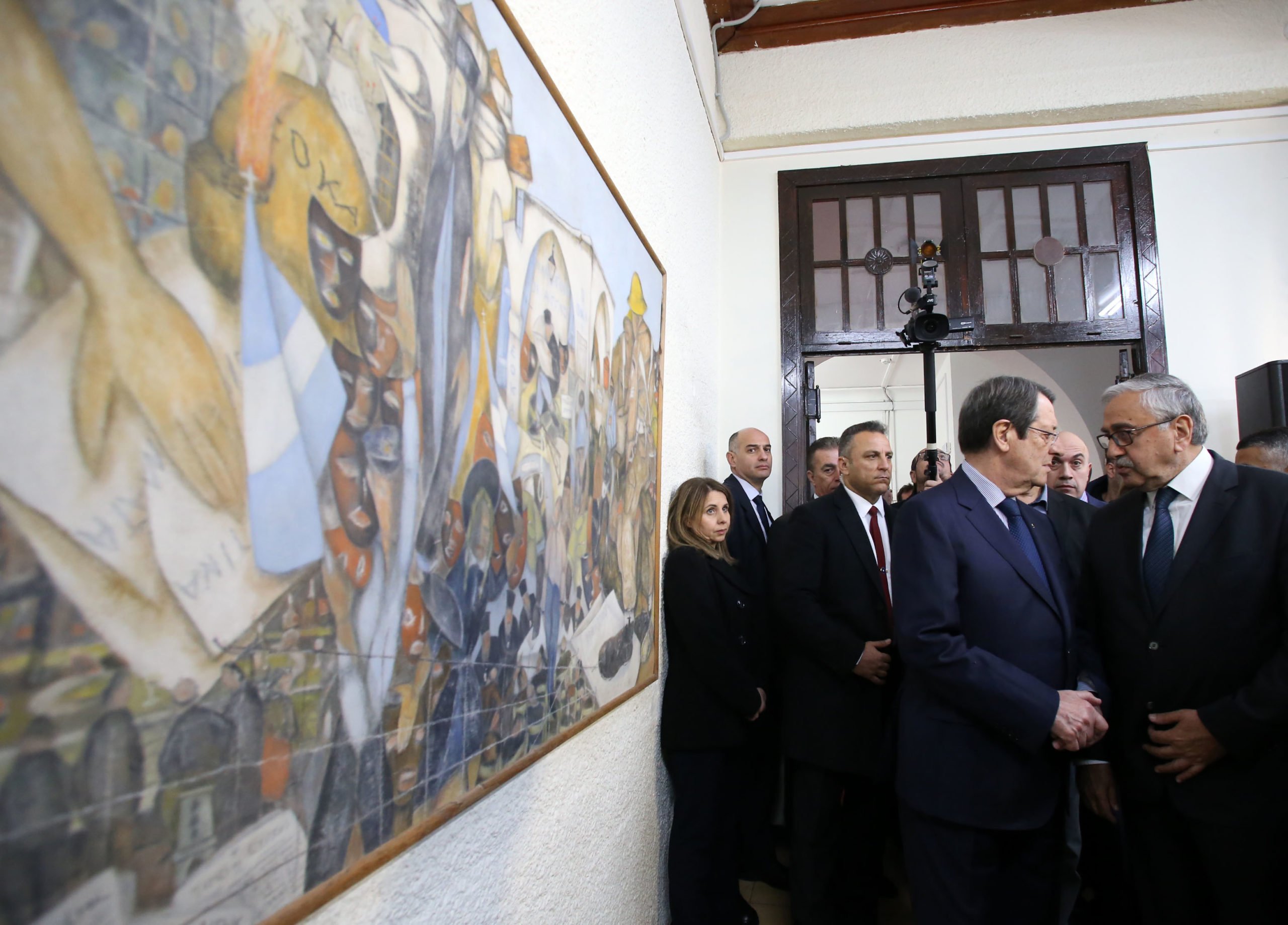The exhibition this week marking the return of 219 works of Greek Cypriot art after 46 years felt like entering a time warp
By Melissa Hekkers
“I walked into the room and I saw it, I didn’t know what to feel, I looked at it and I kept coming back to look at it again… my eye would fall on it and eventually it started moving, it started coming alive,” says artist Rhea Bailey, describing her feelings after seeing one of her paintings for the first time since 1974.
Even more poignantly, the painting is a self-portrait of Bailey as a young woman holding her baby with a long-departed black cat in the corner. The words ‘time warp’ do not begin to do justice to her encounter with the woman she was 46 years ago.
Standing in front of her painting that was on display at the Ledra Palace hotel in Nicosia’s buffer zone earlier this week, she describes how she hasn’t seen it since the spring of 1974 when she exhibited it, along with a series of other works, in a solo exhibition at the Lykeio Ellinidon in now occupied Famagusta.

“I had an exhibition there in the spring, during the Orange Festival,” recalls Bailey as we delve into the details of the 219 Greek and Greek Cypriot art works that were rescued in Famagusta after the 1974 invasion and only returned last year as part of a confidence building measure between the two communities.
“About 10 paintings were sold from that exhibition. And one of them was this painting which was bought by the
municipality of Famagusta for its collection, but then it was 1974, that summer we had the invasion and the paintings stayed there except one which went to Sweden, a Swedish tourist bought it.”
Bailey’s self-portrait was one of the 60 art works presented at this week’s exhibition which also included some of the 54 TV recordings and 22 radio recordings belonging to the Turkish Cypriot community which the Greek Cypriot side returned in exchange. The exchange was made possible through the work and cooperation of the Bicommunal Technical Committee on Culture, members of which also curated the exhibition.
The art works had been found in various houses and public spaces in Famagusta after 1974, including the Municipal Gallery and Famagusta port. For over 45 years, most of them were believed lost or stolen, including those by well-known Greek Cypriot painters such as George Pol Georgiou, Stass Parashchos, Michalis Kassialos, Stelios Votsis, as well as prominent Greek painters including Yiannis Moralis, Yiannis Tsarouchis and Nicos Hadjikyriakos – Ghikas to name a few.
Yet even though Bailey had not seen her painting for 46 years, she was aware that it was safe and sound.
“I had a friend, who was a doctor for the UN, and when her friends came over to Cyprus she also took them to Famagusta to see the ‘other side’.

“There was a little church (in Famagusta) that had been turned into a library for children and on the walls my friend saw this collection of paintings and her father noticed my signature under the painting and he said, ‘look! Isn’t this your friend?’ and she called me and described it to me,” says Bailey, adding that she has goose bumps as she recounts her tale.
“And so I learnt that it was okay, that it was in a nice place, that it survived (the war).”
For Bailey, the returned art works go way beyond her finding an old painting, as personal and moving as that is.
“It was impressive to see so many paintings from the past, because actually, not many of us (artists) are still alive. It was moving to see everything there, the history of our art as well as Famagusta; it reminds you of Famagusta when it was alive, there were a lot of things going on there at the time, there was a lot of culture in that town, it was more of an international town than any other town of Cyprus and you could feel that.”
This is echoed by curator and vice co-chair of the committee Yiannis Toumazis who describes Famagusta’s Municipal Gallery as a pioneering institution for its time.

“It had a purchasing policy, a collection policy, an advisory committee, and it was surrounded by intellectuals and artists. Famagusta was very far ahead with regards to literature and the arts in the 60s,” he says.
In terms of who owns what, he explained that the returned works fall into three main groups. Based on the evidence most of them — around 140 — are certainly from the Famagusta Municipal Gallery.
“Many works still have the signage of the gallery as they were exhibited, with the number of the work, the title etc,” he says.
Another group of 44 works belong to George Pol Georgiou: three belong to the Municipal Gallery and 41 come from his home on Ermou Street.
“We know a lot about Georgiou already, but for me the important thing is that we now have his more memorable works, the works that he himself had in his home, his big works, works like ‘Rebirth of Cyprus’, the ‘Port of Rotterdam’. These works are big in size but also monumental, they show us the whole spectrum about this artist,” says Toumazis.
The third major group are 24 art works by Stelios Votsis which were taken to London for a solo show entitled ‘Votsis Written paintings’ at the Commonwealth Institute Art Gallery in 1973. When the works were returned to Cyprus the invasion took place and they remained stuck at Famagusta port ever since.
“People longed for those works, his daughter longed for them, and they’re important for us because we have an exhibition that took place in 1973 and we have it untouched in 2020. It’s stunning. Time turn backs.”
How the art works will be returned to their rightful owners is still unclear.
“From what I know, there will be an official mechanism identification of artworks because our approach has been a theoretical one so far and then they will be given to rightful owners,” he says.
Naturally the works have endured hardships and have to be restored.
“My piece isn’t intact, there are a couple of holes in it and some paint ran but still, there is that energy coming out from it,” says Bailey, “I admire the technique there… in that painting I see a young force, my next works are more symbolic… You mature and that youthful force goes into the next one.”
The return of the works has also greatly enriched the history of art in Cyprus from the 1920s through to 1974.
“We have new elements,” says Toumazis and cites the 63 portraits by the Famagusta artist Michalakis Hadjidemetriou Hadji who died in 1963.
“Ηe donated 380 portraits of people from Famagusta from the beginning of the century, from the 1920s and 30s and we now have 63 of them… we see how surprising his technique was, with impressionism and expressionism together,” he says.

“He was a great artist about which we didn’t know much because his works were in Famagusta and he didn’t really show his work.
“Beyond the emotional part of the return of these works, they are works that are representative of the times because they were bought or made by the artists who were important at the time and they were bought by a Municipal Gallery, they’re very rich content.”
For Bailey, the exchange rings like a new era, “a profound experience of the past meeting the future in the present”.
“People wrote to me that they were moved when I told the story of the painting and it’s not just my story, it’s what it ripples out, it’s what it means to everybody.”
The art exhibition at the Ledra Palace has now closed, but a full-blown exhibition of the 219 artworks is expected to take place at the State Gallery of Contemporary Art – Spel in March.


